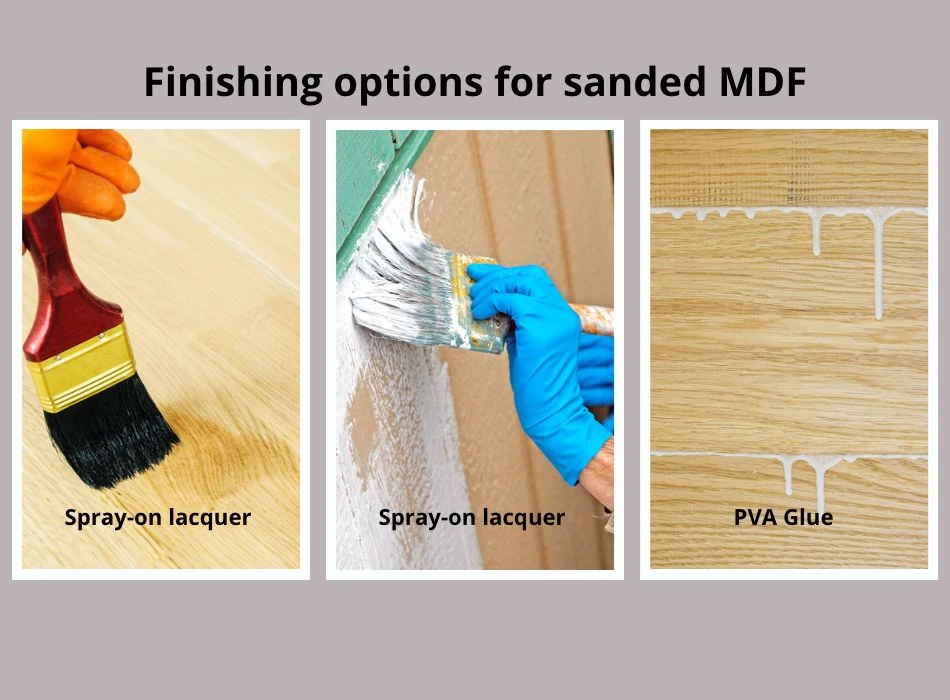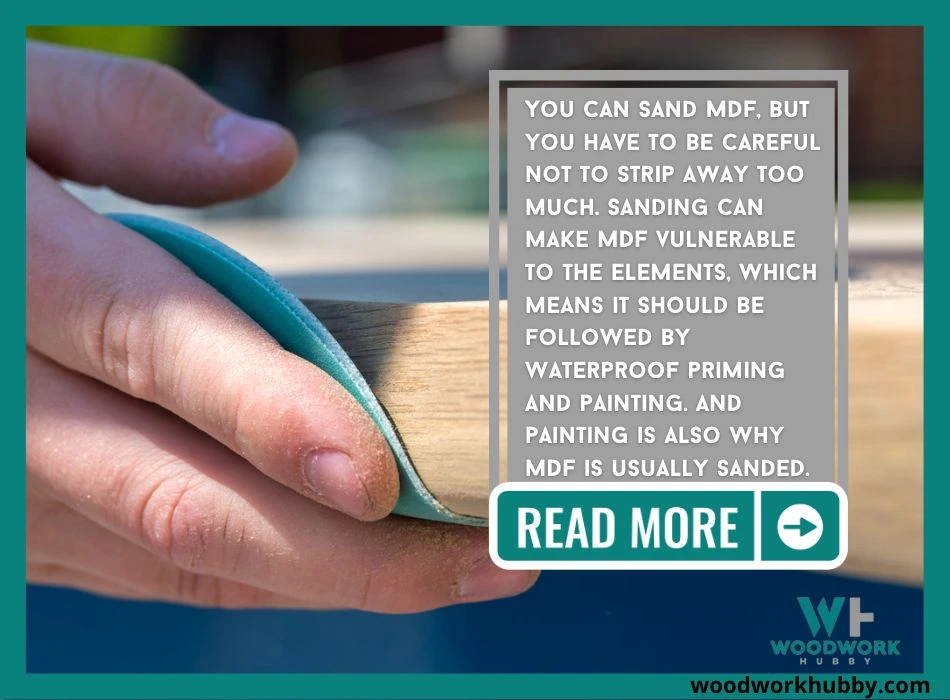As a cabinetmaker, I absolutely have spent a long time over the last 20 years sanding MDF. We commonly used MDF on kitchen doors when they had to be painted so sanding was a must. I still get asked, can you sand MDF?
MDF can be sanded conveniently with a hand sanding block or electric sander with 120-grit sandpaper just like you would do with real wood. Care should be taken as MDF is softer than wood and you must wear a dust mask due to the fine dust particles it produces.
In this article, you will learn more about the specific dos and don’ts of sanding MDF and the pros and cons of doing so. By the end of this post, you will know everything I have learned about MDF painting and sanding in 20 years of woodworking.
Can You Sand MDF?
MDF is easy to sand and can be done just like sanding any other surface. Care should be taken as MDF is a man-made product and is softer than real wood and produces much finer dust.
A video showing how to paint MDF like a professional.
Is It Safe To Sand MDF?
It is safe to sand MDF in the sense that you can protect yourself while doing it. However, it is not safe for the MDF since it becomes less water resistant and structurally durable. You can offset some of the drawbacks of sanding MDF by choosing waterproof paint.
But before you do anything to minimize the drawbacks of sanding MDF, you should know what the disadvantages are. In this section, I will cover the main pros and cons of sanding MDF so you can know if the risk of sanding it is worth the advantages.
Be sure to see my article on how to screw MDF without splitting it.
The Advantages Of Sanding MDF
If you sand MDF, you can make it relatively more paint-friendly. Depending on your technique, the paint can look pretty smooth and professional on lightly sanded MDF. Paint on regular MDF doesn’t look as good.
Aside from making MDF easier to paint and better-looking post-painting, sanding doesn’t do much else. And with that out of the way, we can look at how safe the MDF remains after it has been sanded.
The Disadvantages Of Sanding MDF
The main drawbacks of sanding MDF are that it loses its moisture resistance, can become too rough, and can lose its structural cohesion. The glue that binds wood fibers into MDF can get eroded when sanding.
This leaves MDF unprotected and at the mercy of other measures like waterproofing, sealing, and safe storage. I don’t think that is a fair trade, and the risk at which you put MDF when sanding it isn’t worth the upsides that can be achieved by other means. I will cover those later.
First, we must look at how the disadvantages of MDF sanding can be minimized. The table below sheds light on these.
| The disadvantages of MDF sanding | How to fix it |
|---|---|
| MDF becomes less water resistant | Use waterproof primer, paint, or sealer |
| MDF can lose fibers | Use appropriate grit sandpaper |
| MDF can incur damage when sanding | Use appropriate grit sandpaper |
| MDF might become uneven | Use appropriate grit sandpaper |
| MDF can become weak | Fortify MDF with other materials |
As you can see, a majority of the solutions revolve around sandpaper grit. If you select the right sandpaper, you will not make the mistake of taking too much off its surface when sanding. Nor will you sand too little at a time and waste hours trying to prepare MDF for painting or finishing.
What Grit Sandpaper To Use On MDF?
You should use 120-grit sandpaper on MDF initially and follow it up with 180-grit and 320-grit sandpaper, respectively. Depending on the level of smoothness you want, one of these will work.
As a rule of thumb, you should remember that the lower the grit, the harsher the stripping. Because you’re not removing a layer of paint from MDF but are actually opening it up to soak up paint, you should use 120-grit or higher.
120-grit works best for the edges, and 180 works best overall. 320-grit ensures that the opened-up MDF becomes smooth enough. It gives one of the finest finishes. The grit choice, then, depends on what the goal of sanding MDF is.
- 120-grit – To sand the MDF edges that repel many types of paint.
- 180-grit – To sand MDF with a power sanding
- 320-grit – To make MDF smooth if previous attempts leave it uneven
The greatest drawback of sanding MDF doesn’t come from anything other than the technique you use for sanding. And that is the uneven texture. Depending on how well you can maintain uniformity when sanding, the MDF will come out looking professionally prepped or beaten up.
I have spent 20 years woodworking and have at least a decade of working with MDF. And still, I find that sanding leaves imperfections. Fortunately, it is possible to smoothen them out and get the perfect finish anyway.
How To Get A Smooth Finish On MDF?
To get a smooth finish on MDF, you have to lightly sand the edges of the board and move across the surface with higher grit sandpaper. After that, you should paint the MDF and wait for its fiber core to absorb the paint.
After that, you can use even higher-grit sandpaper, usually, 320-grit, to smooth out the painted MDF once it is fully dry. This works, but only if you don’t get too rough with the initial sanding. It is a little hard to keep MDF sanding light and minimal when you use a power sander.
A router also does a good job on MDF. See my article here explaining if can you use a router on MDF.
Whenever I end up stripping a little more off the surface than I am comfortable with, I use drywall compound to level the surface a little bit. The best part about using drywall to fix roughed-up MDF is that it makes the surface smooth yet lets the MDF beneath the drywall compound absorb the paint.
So if your goal behind sanding MDF is to make it more paint-friendly, the drywall compound will not set you back. But if you want to smooth out MDF that became rough with natural deterioration and isn’t supposed to be painted, drywall compound will be a poor filler choice.
The drywall hack is my secret for sanding and painting plywood for small decor objects. That said, I try to avoid all types of sanding when it comes to large MDF cabinets and MDF trim.
Can MDF Be Sanded And Painted?
MDF can be sanded and painted for small decor and visual-appeal projects. But for functional projects, it is better not to sand MDF since the process can compromise the material making it even less water resistant than it already is.
Different MDF projects have different levels of weather-resistance burden, so whether you should sand or paint the MDF depends on the project it will be used for. Let’s look at a few potential uses of MDF and how appropriate it is to sand and paint in each context.
- Light furniture – MDF should not be sanded when used in furniture.
- Cabinets – MDF cabinet doors can be sanded, but only if they are not in the kitchen or the bathroom.
- Moulding – MDF moulding isn’t supposed to be sanded
- Door parts – MDF door parts can be sanded and painted
- Bird feeders – MDF is not a good choice for a bird feeder. But if used, it should not be sanded.
- Drawer parts – Visible drawer parts made with MDF can be sanded and painted.
All in all, sanding MDF before painting is acceptable in very few cases. That’s because MDF is already weak in water resistance and the last thing you want is for an already vulnerable material to become further vulnerable.
You will notice that whenever MDF serves an aesthetic function, it is usually okay to sand it. As mentioned earlier, this has to do with the appearance advantage of MDF that is sanded and painted.
But please don’t assume that means you cannot paint MDF unless it is sanded. Whenever MDF serves a load-bearing or weather-facing function, and you need to paint it, you should avoid sanding it.
Should You Sand MDF Before Painting?
You should sand MDF before painting it only if it is not supposed to be in a humid environment or a high-traffic area. Sanded MDF looks better when painted, but it can be very vulnerable to the atmosphere and the elements.
There are three paths for painting MDF. The first one is to paint MDF without priming or preparing it in any way. If you use paint that already has a bonding agent or is ideal for finished surfaces, like most spray paint, then it will stick to MDF without a high risk of peeling.
Of course, this type of painting has its nuances. Then there is the second method which we have covered for most of this post. You sand MDF so its smoother upper layer opens up, and its powdery core is exposed. The wood fibers at the MDF’s core absorb the paint, producing a better-looking painted surface.
And what’s the third method, you wonder? Using a primer can bypass the dangers of sanding MDF while simultaneously adding the uniformity and adhesion needed for MDF paint.
A video showing the best way to paint MDF.
Here is how the three ways to paint MDF differ in their strong and weak points.
| Painting unprepared MDF | Sanding and Painting MDF | Priming and Painting MDF |
|---|---|---|
| Requires high-adhesion paint | Works with most types of paint | Works with most types of paint |
| Is the quickest way to paint MDF | Takes a little time | Takes the most time |
| It can be expensive if the paint comes at a premium | It is usually not very expensive | It costs money to buy primer |
| Doesn’t weaken the MDF board | Makes MDF vulnerable to moisture | Doesn’t make MDF weak. It might make it more weather resistant |
| Produces the poorest-looking painted MDF | Produces the best-looking painted MDF | Produces the least acceptable, decent-looking MDF |
From the comparison above, you can see that sanding MDF before painting it produces the best-looking result but at a cost. In common use cases, this can be risky because the dangers of MDF sanding outweigh the appearance advantage.
Is Sanding MDF Dangerous?
Sanding MDF is dangerous if the MDF is not waterproofed or sealed after sanding. The resulting board doesn’t have enough internal adhesion to stick together, and the fibers can start falling apart.
If the MDF carries weight, it can give way, and the project can collapse. But since MDF is not usually used in weight-bearing projects, it is generally not very dangerous to sand MDF if you paint it with waterproof paint or finish it with a sufficiently moisture-resistant coat.
Finishing options for sanded MDF include:

- Spray-on lacquer – This seals the MDF, effectively shutting it off from the elements to which it is exposed upon being sanded. It brings MDF closest to its unsanded form in terms of moisture resistance.
- Oil-based sealant or primer – Oil-based sealant covers the MDF so that the inner wood fibers don’t lay bare. Good sealants keep the MDF from losing fibers.
- PVA Glue – PVA glue does an excellent job of filling MDF and holding together fibers that might otherwise escape. It doesn’t turn MDF into a marine-grade material but does a decent job of priming the surface for painting. It is better used as a primer than a sealer.
At this point, you might be thinking about what I usually think about sanding MDF. It is not worth the trouble. That said, I find sanding MDF to be the perfect solution in a few cases. One of those cases is when MDF’s top layer is damaged.
| My Recommended Finishing Options Products | Where To Buy? |
|---|---|
| Minwax 15210 Clear Aerosol Lacquer Spray, 12.25-Ounce, Satin | AMAZON |
| Zinsser 3608 Cover Stain Oil Base Primer Spray, 13 oz, White | AMAZON |
Can You Sand Water-Damaged MDF?
You can sand water-damaged MDF and should, in fact, do it as soon as possible. Water soaked in by MDF’s top later makes it’s way further into MDF’s depth unless the top layer isn’t sanded away as soon as possible.
You should dry water-damaged MDF with a blow dryer or a dehumidifier and should immediately sand the bloated areas in the board. When sanding for painting purposes, you use high-grit sandpaper.
But when it comes to sanding water-damaged MDF, you should choose a coarse grit sandpaper and a power sander to strip as much top surface as possible. Once you see no signs of bloating or bubbles in the MDF, you can stop sanding.
Can You Sand MDF Skirting?
You have to sand unprimed MDF skirting before painting it. Otherwise, you should use a high-adhesion primer and coat the skirting with paint directly. Even the lightest punishment to skirting’s top layer can affect the board’s longevity, so you have to be careful.
Safety Tips On What To Use When Sanding MDF?
Whether you lightly sand MDF skirting or heavily strip water-damaged MDF, you need to make sure you are safe, and the MDF is not at risk. Here are my safety tips for sanding MDF.

- Use a respirator – MDF has a solid adhesive core, and when it gets obliterated into airborne chunks during power-sanding, you don’t want the particles getting into your respiratory system.
- Wear safety goggles – Wood fiber and adhesive particles can irritate your eyes if they get in.
- Sand by hand first – If you start with a power sander, you might strip too much of the MDF surface. Moreover, you might accidentally hurt yourself.
- Use a primer after sanding – This makes the MDF safe from painting mistakes. It is not as much a woodworker safety tip.
- Seal the material – Sealing MDF after it has been painted can reduce the risk of rot and water damage.
Final Thoughts – Can You Sand MDF?
You can sand MDF if you plan to prime and paint it afterward. The paint coat can make the MDF less vulnerable to moisture, which makes up for the loss of moisture resistance that comes from sanding.




